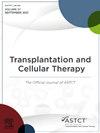Efficacy of Pomalidomide on Motor Performance and Functional Abilities in Patients with Steroid Refractory Chronic Graft Versus Host Disease: A Randomized Clinical Study
IF 3.6
3区 医学
Q2 HEMATOLOGY
引用次数: 0
Abstract
Deficits in motor performance and functional abilities represent a severe complication for individuals with steroid refractory chronic graft versus host disease (cGVHD) and is associated with decreased survival and high morbidity. The objective of this study was to characterize the impact of pomalidomide on motor and functional outcomes in patients with cGVHD. Thirty-four adult patients with cGVHD were enrolled in a randomized and unblinded trial. Pomalidomide was administered orally at two dose levels: low (0.5 mg/d) or high (initial 0.5 mg/d, escalating 0.5 mg/d every 2 weeks to a maximum 2 mg/d). Efficacy was assessed primarily by the Activity Card Sort (ACS), 2 Minute Walk Test (2MWT), Medical Outcomes Study Short Form 36 (SF-36), Active Range of Motion (AROM), Disabilities of the Arm, Shoulder, and Hand (DASH), and Manual Abilities Measure 36 (MAM). Compared to baseline, the pooled sample of study participants at 6 months showed improvement in hand skills (MAM, P = .01), upper extremity (UE) function (DASH, P = .01), and health related quality of life (SF-36 Physical Component Summary score (PCS), P = .02). Though no statistically meaningful differences between the two dose groups were found, the low-dose group had greater improvements in AROM, walk distance, UE and hand function, and in the high-demand physical leisure and social subdomains of the ACS as compared to the high-dose group. Responders to pomalidomide performed better than nonresponders on most measures at the 6-month endpoint. The study suggests pomalidomide, at both dose levels, may improve several aspects of motor and functional abilities. However, further study is warranted to determine if the trends found in this study, are sustained over time in larger, and in more diverse cGVHD populations. The findings highlight the potential utility of administering functional and motor tests, such as the ACS, DASH, and MAM, to patients with cGVHD, to fully elucidate the efficacy of treatment options for persons with steroid refractory cGVHD.
波马度胺对类固醇难治性慢性移植物抗宿主病患者运动表现和功能能力的影响:一项随机临床研究
背景:运动表现和功能能力缺陷是类固醇难治性慢性移植物抗宿主病(cGVHD)患者的严重并发症,并与生存率降低和高发病率相关。目的:表征泊马度胺对cGVHD患者运动和功能结局的影响。研究设计:34名成年cGVHD患者参加了一项随机、非盲法试验。口服波马度胺两种剂量水平:低(0.5mg/d)或高(最初0.5mg/d,每2周增加0.5mg/d至最大2mg/d)。疗效主要通过活动卡分类(ACS)、2分钟步行测试(2MWT)、医疗结果研究短表36 (SF-36)、活动范围(AROM)、手臂、肩膀和手的残疾(DASH)和手工能力测量36 (MAM)来评估。结果:与基线相比,6个月时研究参与者的合并样本在手部技能(MAM, P = 0.01),上肢(UE)功能(DASH, P = 0.01)和健康相关生活质量(SF-36身体成分总结评分(PCS), P = 0.02)方面均有改善。虽然两个剂量组之间没有统计学差异,但与高剂量组相比,低剂量组在AROM、步行距离、UE和手功能以及ACS的高需求休闲和社交子域方面有更大的改善。在6个月的终点,对泊马度胺有反应的患者比无反应的患者表现更好。结论:该研究表明,两种剂量水平的泊马度胺都可能改善运动和功能能力的几个方面。然而,需要进一步的研究来确定本研究中发现的趋势是否在更大、更多样化的cGVHD人群中持续一段时间。研究结果强调了对cGVHD患者进行功能和运动试验(如ACS、DASH和MAM)的潜在效用,以充分阐明治疗方案对类固醇难治性cGVHD患者的疗效。
本文章由计算机程序翻译,如有差异,请以英文原文为准。
求助全文
约1分钟内获得全文
求助全文
来源期刊

Transplantation and Cellular Therapy
Medicine-Hematology
CiteScore
7.00
自引率
15.60%
发文量
1061
审稿时长
51 days
 求助内容:
求助内容: 应助结果提醒方式:
应助结果提醒方式:


